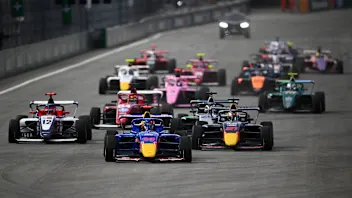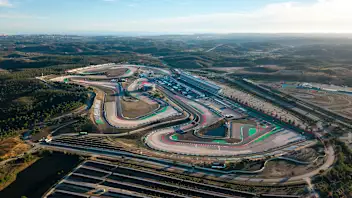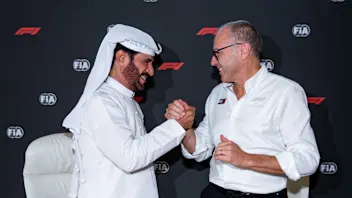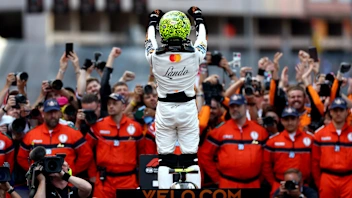In his lengthy F1 career, Williams’ technical director Pat Symonds has had to deal with more than one major regulation change, though few have been as substantial as the ones introduced for the 2014 season. Ahead of this weekend’s season opener, the 2014 Formula 1 Rolex Australian Grand Prix, we spoke to the experienced engineer about overcoming teething troubles in testing and Williams’ impressive early form…
Q: In terms of Williams’ pre-season, did things go more or less as you expected?
Pat Symonds: No, I think we were expecting more problems than we had. We didn’t take these (rule) changes lightly - they’re significant. I had anticipated that there would be a lot of teething problems - and of course there were a few - but by the time we finished, it was almost like running a V8 at the end of the season rather than the new power unit at the beginning of the season.
Q: Wow, that’s a rarity!
PS: It is. We covered nearly 5,000km in testing - in 12 days, that’s going some.
Q: Do you think there’s a reason Williams found it slightly easier than other teams?
PS: Well the Mercedes power unit is obviously the class of the field, so that certainly helped us. But even so, you’re relying on good, solid engineering for the integration of that power unit into the chassis. We’ve got a really good design team at Williams who’ve done a fabulous job with it.
Q: What about the new brake-by-wire system? A lot of teams had problems with it…
PS: We weren’t without problems with it. We had a few little teething problems in Jerez, but before we left Spain we were on top of those problems and it’s been faultless ever since.
Q: So in Jerez you managed to get a lot of major jobs ticked off your ‘to do’ list?
PS: Yes, but the signing off process was still going on into the final couple of days of testing. Jerez was pretty good to us - we had three pretty good days and one slightly troubled day, but we did get through things.
Q: As a team you’ve recruited quite heavily over the last 12 months. Has that process come to an end now in terms of major moves?
PS: Yes, I’m pretty happy with what we’ve got. You say we recruited quite heavily, but it wasn’t like we were bringing in hundreds of people - we just cherry picked a few people to augment what we’ve got. There was a really good core of staff at Grove and it was just a case of looking at areas where they needed a bit more help and bringing in a few people to assist in those areas.
Q: After such a good pre-season, morale in the team must be quite high. A popular phrase being thrown around is ‘cautiously optimistic’…
PS: It’s quite a good phrase isn’t it? (laughs) Certainly morale is high and I think self-belief is coming back - that’s something that the guys at Grove had lost a bit last year. So I can live with the phrase ‘cautiously optimistic’.
Q: You obviously have a lot of experience - does that make you more circumspect about the team’s chances?
PS: In the past I’ve found things have been different to what I expected (at the first race) in both a better and a worse way. There’s no point in speculating - it achieves nothing. Let’s wait for facts.
Q: Fuel management is something that is expected to be a big factor in 2014 - are Williams well on top of it?
PS: I think we are well on top of it and I think it’s because we spent a lot of time focusing on it. It doesn’t give me any concerns.
Q: Tyres have obviously been the big talking point over the last few years - do you think that fuel will be this year?
PS: It’ll be much more transparent. Firstly, the 100kg limit is not a real limit at a lot of circuits. Those circuits where we are limited - and we’re starting with one in Australia - I think we’ve learnt enough about managing fuel. Everyone thinks this is something new, but we’ve been managing fuel for years - it’s always been our target to finish the race with a few hundred grams of fuel. It’s nothing different. I don’t see it as a big issue.
Q: The drivers have spoken about how much more torque the new power units produce compared to the old engines. Has that has a big impact on rear tyre degradation?
PS: Yes.
Q: So is rear tyre wear going to be a big issue do you think?
PS: I don’t really like to predict that. Pirelli seem happy with how things are going and I think they should be because they’ve hit it about right. They have toughened up the tyres to cope with the extra torque. Rear tyres will be a limitation because of the extra torque, but the tyres didn’t perform badly in Bahrain.
Q: How hard is it to make real progress with your car once you’re into the first four flyaway races?
PS: I think the significant thing is that once you’re in the ‘racing season’, it’s actually quite hard to do the experiments that you need to do. That’s the great thing about testing - you’ve got enough tyres and enough time to do things. When you get to a race you’re limited in time, but more importantly you’re limited on tyres. So it’s hard to do the development work you’d like to do on the car. But that doesn’t mean we’ll stop doing it. A lot of the lessons we learnt in Bahrain, we’re designing parts for now that we’ll bring to the first four races.
Q: Looking ahead, one imagines you have a plan in terms of updates. Will we see upgrades in the first four races or will we have to wait until the start of the European season?
PS: No, there’ll be some things before that. The development list is long now - I won’t say how many items are on it, but there are a lot. Some of those items will be seen certainly prior to coming back to Europe. In Europe we will see a little bit more probably, because there are some things that are easier to do when you get your car back to base. But that doesn’t mean we won’t be updating at the first four races.
Next Up
Related Articles
 F1 ACADEMY unveils calendar for 2026 season
F1 ACADEMY unveils calendar for 2026 season Formula 1 to return to Portugal in 2027 and 2028
Formula 1 to return to Portugal in 2027 and 2028 F1, the FIA and 11 teams sign 2026 Concorde Agreement
F1, the FIA and 11 teams sign 2026 Concorde Agreement Sainz hopes point-less finish in Abu Dhabi ‘serves as a wake-up call’
Sainz hopes point-less finish in Abu Dhabi ‘serves as a wake-up call’ PalmerThe 6 defining moments of Norris’ title-winning season
PalmerThe 6 defining moments of Norris’ title-winning season 10 ways to get your Formula 1 fix during the winter break
10 ways to get your Formula 1 fix during the winter break